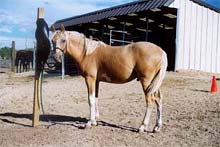|
Pawing Horse Behavior by Raye Lochert
Teaching Our Horse to be comfortable Giving to Pressure and Standing Tied
Everywhere I go I often hear the same question. “How do I get my horse to stop pawing?” Horses paw in all sorts of places including
the trailer, outside the trailer, at the tie rail and in the stall. They dig large holes, knock off hubcaps and damage fenders. People try to
stop the pawing in many ways including yelling at their horse or throwing rocks at him. Usually these methods are unsuccessful and produce negative results.
 You cannot stop your horse from pawing unless you understand why he paws. One reason your
horse paws is because he is anxious or afraid. The horse that is fine at home but paws at Clinics or shows is showing anxiety because of all the unfamiliar surroundings and activities. These are
emotions that make him uncomfortable. You can’t physically stop him from pawing but you can to teach him to handle his emotions. Other reasons for pawing are the horse may be in pain. Be sure
to eliminate this as a reason with your Veterinarian. Another common reason is the horse has been rewarded in the past for pawing. He was out of food or water and began to paw, you noticed he
was out of food or water and solved his problem. In the horses mind he has now taught you a trick, the horse paws and you give him a reward of food. Change your behavior by feeding when he is quiet. You cannot stop your horse from pawing unless you understand why he paws. One reason your
horse paws is because he is anxious or afraid. The horse that is fine at home but paws at Clinics or shows is showing anxiety because of all the unfamiliar surroundings and activities. These are
emotions that make him uncomfortable. You can’t physically stop him from pawing but you can to teach him to handle his emotions. Other reasons for pawing are the horse may be in pain. Be sure
to eliminate this as a reason with your Veterinarian. Another common reason is the horse has been rewarded in the past for pawing. He was out of food or water and began to paw, you noticed he
was out of food or water and solved his problem. In the horses mind he has now taught you a trick, the horse paws and you give him a reward of food. Change your behavior by feeding when he is quiet.
Lets work on anxious or afraid as the reason for pawing.
What not to do: Teaching your horse to be comfortable is not accomplished by yelling at him, throwing rocks at him or causing him to fear you. These actions only raise his emotional level higher risking a fight or flight response. Never punish a horse while he is tied.
This will cause the horse to pull back which creates a whole new set of problems. You must remember when teaching your horse a new
skill you want to set him up for success. This means that you give him only what he can handle. Remember that your goal is for your
horse to be comfortable. Punishing your horse will only take you further from your goal.
What to do: The first step is to be sure your horse is comfortable giving to pressure. Your horse needs to know how to move
towards the pull of the halter. If he pulls back then he’s not ready to be tied.
Next you need to find a safe place to tie your horse. Find a good tie rail or ring that is located in an area free of clutter or other
dangerous obstacles. A good place to start could be his stall if you are safe there. You must always be sure that you work with your horse in an area that is as safe as possible just in case he panics.
What you will be doing in this lesson is raising your horse’s emotions only as high as you think they can go before he starts pawing. Just
when you think he has reached his limit you will lower his emotions. In each step you will raise his emotions higher and higher until the pawing stops altogether.
1)
Tie your horse up near a buddy or with some hay and stay close by. Tie him for a very short time – maybe a couple of minutes or
less. Then untie him and walk away. Remember: You want to untie your horse BEFORE he starts to paw.
2) Continue this process gradually increasing the period of time he is tied.
3) Once he is standing without pawing for 15 minutes, remove the hay or his buddy for a very short amount of time and then bring it
back. Don’t take the buddy so far away that your horse begins to paw.
4)
Gradually increase the amount of time the buddy/hay is removed. REMEMBER: You are not trying to make the horse feel comfortable standing tied. You are LETTING HIM LEARN to be comfortable.
Repeat this lesson over several days. Take lots of breaks. You can even work on other lessons in between sessions. Gradually work
up to leaving your horse tied alone for an hour or two. Be sure to never leave him tied in hot sun, other unsafe inclement weather, or in an environment where he could get hurt when panicked or spooked.
Always remember, we will have our horses for many years. Don’t rush the next few minutes, hours or days. When your horse learns
in a positive environment you have a much better horse.
|